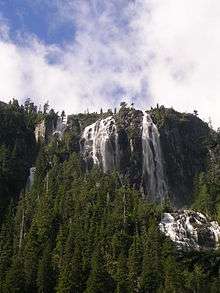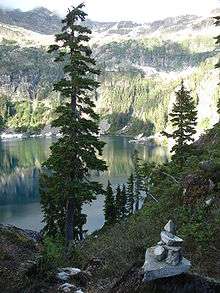Strathcona Provincial Park
Understand

The Clayoquot Sound Biosphere Reserve, established in 2000, includes three watersheds in the western area of the park.
Although there are no commercial tourist facilities in the park, the nearby Strathcona Park Lodge and Outdoor Education Centre provides outdoors education. Visitor facilities are available in the nearby communities of Campbell River and Gold River.
History
Strathcona Provincial Park is the oldest provincial park in British Columbia, Canada, and the largest on Vancouver Island. Founded in 1911, the park was named for Donald Alexander Smith, 1st Baron Strathcona and Mount Royal, a wealthy philanthropist and railway pioneer.
This area is the traditional territory of the Mowachaht and Muchalaht people of the Nuu-chah-nulth First Nation. Commander John Buttle, for whom Buttle Lake is named, was the first European to explore the area in the 1860s.
In 1894 and 1896 the area was explored by Reverend William W. Bolton. Bolton's explorations and federal government interest in establishing a national park led BC Premier Sir Richard McBride to set aside a park reserve in June 1910.
The First World War caused elaborate plans for a railway and two hotels to be abandoned. As part of the war effort, there was logging in the Elk River Valley. Over the years which have followed, other industrial uses have affected the park. In 1939 mining and logging became permitted in the park and in 1959 the Westmin Mine was opened. This mine continues to operate in a section of the park called Strathcona-Westmin Provincial Park.
The area around the shoreline of Buttle Lake was logged to accommodate the increase in water levels from the Elk Falls hydroelectric project in Campbell River in 1948 which also raised water levels in the Elk River. The variation in water levels in the lake periodically exposes lake bottom and stumps from this logging and is considered unsightly.
In 1987 the provincial government announced plans to remove large areas from the park for logging and other industrial uses. The Friends of Strathcona formed a blockade which attracted significant media attention and resulted in the arrest of 63 protesters. An independent review of the future of the park resulted in the Strathcona Park Master Plan. Most of the park is designated a conservation area under this plan.
Landscape
It covers 2,458 km². The Elk River Mountains and the highest peaks of the Vancouver Island Ranges are found here. Some notable mountains within the park boundaries include:
- Golden Hinde (2198 m)
- Elkhorn Mountain (2166 m)
- Mount Colonel Foster (2129 m)
- Mount Albert Edward (2093 m)

Strathcona Park is also known for its lakes, waterfalls, and glaciers. Buttle Lake is a popular destination for swimming, canoeing, kayaking, and fishing. Also in the park is Della Falls which, at 440 m in height, is widely considered the highest waterfall in Canada.
The 6,500-meter-thick Karmutsen Formation is the most abundant rock unit in the park. It is a pile of tholeiitic pillow basalts and breccias. It is also the oldest, thickest and most widespread formation on Vancouver Island found on Triple Peak, Cat's Ears Peak and the Mackenzie Range.
Flora and fauna
Sub-alpine ecosystem: western redcedar, Douglas fir, grand fir, amabilis fir, western hemlock, mountain hemlock and creeping juniper
Wildlife: Roosevelt elk, Vancouver Island marmot, Vancouver Island wolf, cougar and the coastal black-tailed deer
Birds: chestnut-backed chickadee, red-breasted nuthatch, winter wren and kinglet, gray jay, Steller's jay, blue grouse, ruffed grouse and white-tailed ptarmigan
Climate
Summer in Strathcona is usually pleasantly warm, while winters are fairly mild except for the higher levels, where heavy snowfalls are the norm. From November through March, snowfalls can be expected on the mountain slopes and alpine plateaus. Snow remains all year on the mountain peaks and may linger into July even at moderate elevations. Summer evenings, as elsewhere in the coastal regions of BC, can be cool and rain can be expected at any time of the year.
Get in

The park is 9 km east of Gold River and 41 km west of Campbell River on Highway 28.
There are two points of access for day users: Buttle Lake and Forbidden Plateau.
- Buttle Lake: The main access to Strathcona Park is via Highway 28, which connects with Gold River on the west coast of Vancouver Island. Follow Hwy 19 north past Courtenay to Campbell River, then follow Hwy 28 west for 48 km. Hwy 28 passes through the northern section of the park and provides access to Buttle Lake. Gas and services are not available between Campbell River and Gold River.
- Forbidden Plateau: The main access route to Forbidden Plateau from Courtenay and Campbell River is via the Paradise Meadows Trailhead at Mount Washington. From Highway 19 follow signs to Mount Washington Ski Resort via exit #130 (the Strathcona Parkway) for 20 km. Turn left onto the Nordic Lodge road for 1.5 km to the Paradise Meadows parking lot.
Fees and permits
Get around
See
Do

The park is a popular destination for hikers, mountain climbers, swimmers, canoeists, and kayakers. There is an extensive network of hiking trails in the park; visitor facilities are located at Buttle Lake and Forbidden Plateau. The park includes campgrounds, backpacking and cross-country skiing trails, and downhill skiing. There is fishing, in season, for cutthroat, rainbow, and Dolly Varden trout.
- Canoeing and kayaking is popular on Buttle and Upper Campbell Lakes. Buttle Lake is subject to strong afternoon winds that may be very hazardous to small craft. Canoeists and kayakers should exercise caution at all times.
- Climbing and rapelling: Crest Creek Crags offers more than 150 climbing routes for various skill levels. Ensure you and your climbing partner have the skills, equipment and experience to climb safely. Crest Creek Crags is accessed via Hwy 28 from Campbell River; approximately 11 km east of Gold River.
- Cycling: There are some mountain bike opportunities on the west side of the park through Gold River near Kunlin Lake. Bicycles must keep to roadways. Bicycle helmets are mandatory in British Columbia.
- Fishing: Angling can be rewarding on Buttle Lake and on the other lakes and waterways in the park. Cutthroat and Rainbow trout are the primary catch. Tributaries to Buttle Lake are closed to angling. The Elk River is open to catch and release fly fishing only. All anglers should check the current regulations issued by Fisheries and Oceans Canada prior to fishing for other restrictions. Anyone fishing or angling in British Columbia must have an appropriate licence.
- Hiking: Numerous hiking trails, ranging from 20-minute ambles to arduous, multi-day hikes and mountaineering adventures.
- Flower Ridge Trail. The trailhead for this trail is located immediately South of Henshaw Creek near the southeast side of Buttle Lake. There is significant parking and an info board just North of the creek. The trail rises 1200 m during its 6 km. It is easy to follow without large switch-backs. It took a group of hikers with moderate experience about 5 hours to the edge of the ridge and 2½ hours down.
- Paradise Meadows Barrier-Free Centennial Trail: An easily accessible sub-alpine trail which is suitable for everyone.
- Hunting: Hunting is only permitted in the McBride Creek and Megin-Talbot areas of Strathcona Park for specific species in season. Hunters must have valid licences and tags.
- Interpretive programs: The Strathcona Wilderness Institute, through the Strathcona Park Wilderness Centre, offers nature walks, talks, and hikes. The Wilderness Centre building is at the Paradise Meadows trailhead in Strathcona Park, adjacent to Mt. Washington’s Raven Lodge, the nordic ski lodge. The Centre provides visitor information, maps, books, and refreshments.
- Swimming: Good swimming is available in Buttle Lake, near the Buttle Lake and Driftwood Bay campgrounds. Buoys mark the designated swimming areas. Although the water is cold, swimming is permitted in all the lakes in the backcountry except for Kwai Lake. There are no lifeguards on duty at provincial parks.
- Waterskiing and windsurfing': on Buttle Lake.
- Wildlife viewing: Observation platforms to view various waterfalls can be found at Lupin Falls, Lady Falls, Karst Creek and both Lower and Upper Myra Falls. Visitors may see black bears, Roosevelt elk, black-tailed deer, cougars, Trumpeter swans, Bald eagles, whiskeyjacks, squirrels, tree frogs and white-tailed Ptarmigan, and other species inhabiting this wilderness park.
- Della Falls, whose drop of 440 metres over three cascades makes it one of the highest waterfalls in Canada. Opportunities to see wildlife exist throughout the park.
- Backcountry skiing and snowboarding: Developed ski facilities can be found at Mount Washington Alpine Resort, adjacent to the park. Mount Washington often boasts one of the highest snowfalls of any ski resort in North America. Ski rentals are available from Mount Washington or from various commercial outlets in the Comox Valley and Campbell River.
- Cross-country skiing is a popular activity in Paradise Meadows during the winter. More than half of the Nordic trails set by Mount Washington are within Strathcona Park. Ski rentals are available from Mount Washington or from various commercial outlets in the Comox Valley and Campbell River.
- Snowshoeing is popular in Paradise Meadows during the winter. Mount Washington sets some snowshoes trails for beginners; more adventurous visitors can snowshoe at any point in the park. Rentals are available from Mount Washington or from various commercial outlets in the Comox Valley and Campbell River.
Wheelchair access
- Paradise Meadows Barrier-Free Centennial Trail is an easily accessible sub-alpine trail which is suitable for most types of wheelchairs and battery powered scooters.
- Wheelchair accessible facilities are available at the Driftwood Bay group site, Buttle Lake campground (pit toilets only), Elk Portal entrance (pit toilets only). The Crest Creek day-use area offers wheelchair accessible picnic tables and a pit toilet.
- Strathcona Park Trail Rider Wheelchair Program: Based at the Strathcona Park Wilderness Centre at Paradise Meadows trailhead (adjacent to Mount Washington’s Nordic Lodge). The one wheel unit, a cross between a rickshaw and wheelchair, makes it possible for people with mobility restrictions to access the backcountry of the Forbidden Plateau area.
Buy
Eat
Drink
Sleep
Lodging
The Strathcona Park Lodge also offers weekend camps for tourists with activities such as rock climbing, kayaking, hiking, swimming, etc.
Camping
Campsites are available from April 1 to October 31. There are 161 vehicle accessible campsites, 106 wilderness campsites, 5 marine campsites, 1 yurt. 96 campsites are reservable online, the rest are first-come, first-served. Campfires are banned in all areas of the park except in provided fire pits. Drinking water hand pumps are located at the Buttle Lake, Ralph River and Driftwood Bay campgrounds.
Vehicle-accessible sites cost $20 per party per night.
Backcountry
Along the Flower Ridge Trail there are isolated pads in the wooded area at the edge of the ridge, but about an hour farther on there is a barren area with approximately five pads on the edge of a cliff with an impressive panoramic view. Some large rocks have been collected near the pads to hold down tent corners as the dirt is not deep enough for stakes and there is no shelter from wind (so please don't throw them off the cliff). The sparse trees are very stunted so animals might be deterred by hanging food off the cliff.
Fires are not allowed in the backcountry.
Backcountry camping is permitted year-round at Buttle Lake Marine, Elk River, Forbidden Plateau, Bedwell and Baby Bedwell. Per night fee (2018): $10 per adult, $5 per child 6-15.
In the backcountry, drinking water comes from a variety of sources. Boiling, treating or filtering surface water prior to consumption is recommended.
Stay safe
Go next
Mount Washington Alpine Resort, near Courtenay, offers downhill and cross-country skiing. It is adjacent to the park.